The Scottish isle you can only visit on a day trip
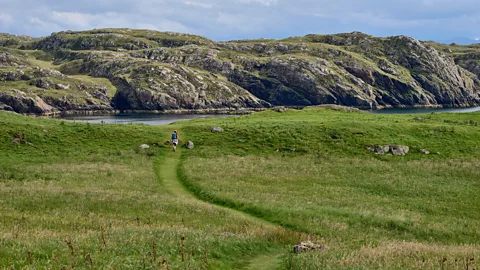 Getty Images
Getty ImagesEvery spring, almost 100,000 seabirds – guillemots, great skuas, razorbills and puffins – descend on the small island of Handa, just off Scotland's far north-west coast.
Handa Island can be glimpsed from many points among the coastline of far north-western Scotland, but its proximity to the mainland means that unless you know what you're looking at – or have a map to hand – you may not realise it's actually an island. At its nearest point, just 350m separate it from the rest of the country; close enough that you might be tempted to think, on a sunny day, to swim out to it, were it not for the chill of the water.
The 10-minute ferry to the island leaves from the small pier at Tarbet, a little hamlet 5.5 winding miles by road from the larger village of Scourie. Approaching its eastern side, and landing on a soft white-sand beach lapped by turquoise water, the island looked surprisingly tranquil, with little indication of the steep cliffs covered in seabirds that it is famous for.
It was these birds that I – and the 14 other passengers on the ferry – had come out to see. During breeding season (April to July), the island is home to around 100,000 seabirds, making it one of the largest breeding colonies in north-western Europe. Among these feathery visitors are Arctic skua, which the Handa Island Wildlife Reserve map, given out during the ranger's introductory talk, advises on how to deal with them swooping towards you: "Hold up your hand and move on quickly." Needless to say, I was relieved when I only encountered the birds sitting on the grass, steadfastly ignoring me.
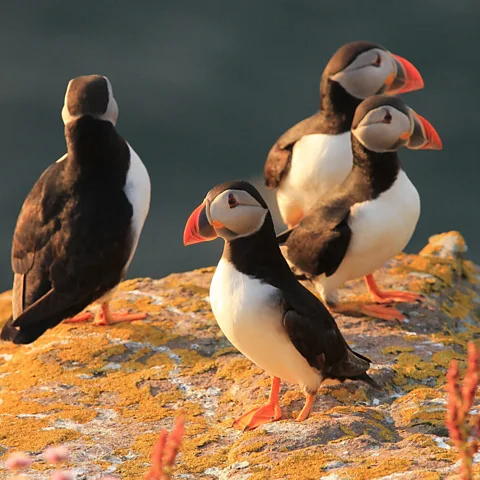 Dora Hamilton/Scottish Wildlife Trust
Dora Hamilton/Scottish Wildlife TrustAll sense of the world beyond Handa dropped away as I walked across the heather-strewn moorland that characterises the middle of the 760-acre island, accompanied only by the bright singing of the skylarks that nest in the ground here.
How to visit Handa Island
The only way to visit the island is on a day trip: the Handa Ferry runs from Tarbet pier between early April and early September (Monday to Saturday, with outgoing journeys between 09:00 and 13:30 and the last return around 16:30). There are no food and drink facilities on the island, so pack a picnic (nearby Scourie has a small grocery shop) and plenty of water. The ranger and volunteers provide information about Handa, but otherwise the visit is self-guided on clear paths. Mackenzie Mountaineering offers guided trips to the island from Ullapool, 48 miles south of Tarbet. The best time to visit to see the seabirds (and particularly puffins) is from mid-May to June.
At Puffin Bay – a misnomer, given it isn't where those little birds nest – on the north coast, the land suddenly gave way to sheer, rocky cliffs of dark Torridonian sandstone, carved out into caves and skinny sea stacks and constantly circled by shrieking kittiwakes. A golden eagle soared overhead, pursued by a raven and seemingly unaware of the small crowd gawking excitedly up at it through binoculars.
It is, however, the promise of puffins that brings many visitors out to Handa. Just 400m west of Puffin Bay is the more appropriately named Great Stack, a large sandstone tower just offshore where many of the island's migratory birds come to live and breed. Even though it was early in the season when I visited, its ledges were already filled with countless squawking seabirds: kittiwakes, guillemots and razorbills, for the most part. But it wasn't long before a ripple of excitement travelled through our group of spectators when someone spotted the tell-tale orange feet of a puffin.
By July, between 300 and 500 of the little birds will be here, though they are at risk from some of the island’s other residents. "Especially rats, which swim over here from the mainland and can burrow just like puffins do, " said Handa Island ranger Libby Higgins.
It was a sobering thought as I watched the little bright-beaked bird on the vertiginous sea stack, next to the monochrome guillemots and razorbills. It was just one of a handful of puffins on the island already; the rest – along with thousands of other migratory birds – would arrive in the weeks that followed, quickly taking up every inch of space and turning the cliffs of Handa into seabird cities.
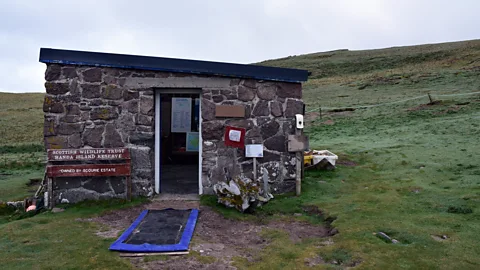 Emma Gibbs
Emma GibbsBirds are not the island's only seasonal residents, however. As ranger, Higgins has been on the island since March and will stay here until the end of the season in September, overseeing the volunteers who come out to work here for four weeks (or more) at a time; there’s usually around six volunteers on the island at one time.
Volunteering on Handa
Volunteers are a mix of monthly volunteers and long-term assistant rangers, the latter of whom stay for eight to 21 weeks. Applications for the roles usually open early in January each year and are advertised on the Scottish Wildlife Trust’s website. Conservation experience and bird knowledge are helpful but not essential, and all volunteers receiving training when they arrive on the island.
"We live communally," she told me, "So we all pitch in and cook meals together. It's a bit like being a family." Once Higgins leaves in September, the island will be uninhabited (by humans, at least) until the following March.
Accommodation is in bunk beds in a simple, two-roomed mixed-sex hut, set some distance from the paths visitors use. Volunteers have to bring enough food with them to the island to cover at least their first two weeks; the nearest shop is in Scourie, which can be reached on a 3.5-mile walk across rather rough moorland, but being able to do so relies on the weather to be good enough for the ferries to run.
While I was on the island, Higgins was busy training up the newest volunteers so they could help with the ferry unloading and loading; volunteers also monitor the seabird populations, clean the beaches and maintain the boardwalks.
"Every day can be different," volunteer Nicole Smith told me. "You have to be able to live without a lot of the things you take for granted on the mainland, but I've found that a simple way of life is very rewarding." Smith, who is from Aberdeen and in the process of changing career paths, was volunteering on Handa to gain experience in the conservation sector. "The opportunity to work on this fantastic island has been life changing," she said.
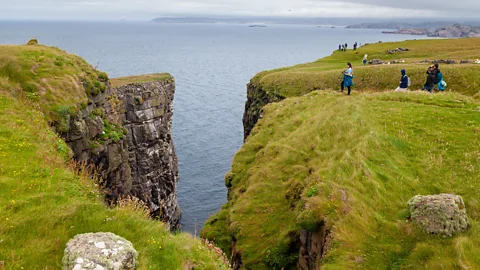 Alamy
AlamyFrom the Great Stack, I watched as the mainland beaches of Oldshoremore and Polin – 11.5km away as the crow (or rather, the skua) flies – were obscured from view by the haar (sea mist) rolling across the water. By the time I'd walked to the cliffs at Geodh' na Goibhre, 600m further on, the thick white wall of fog had reached the island and I had just long enough to locate the orange flash of a puffin beak before the haar played a magician's trick and made the cliffs disappear from sight.
More like this:
• 10 sustainable travel destinations to visit in 2024
If anything, Handa became even more spectacular at that moment – without being able to see the cliffs, the squawks and calls of the seabirds took on an eerie feel, echoing around the landscape like spectres.
Carbon emissions:
The travel emissions it took to report this story were 0.51 metric tons of CO2e. Find out more about how we calculated this figure here.
This being the Highlands, the weather refused to stay the same during my time on the island, and by the time I'd reached southerly Boulder Bay, I could see all the way across to the distinctive Old Man of Stoer sea stack, 16km away. Oystercatchers scurried and squeaked their way along the shore and a lone seal stuck its nose out of the water – which I learnt from the reserve map was called "bottling". Shortly after, a French couple stopped me to point out a common snipe among the long grasses, making a distinctive, repetitive call that sounded like a squeaky toy.
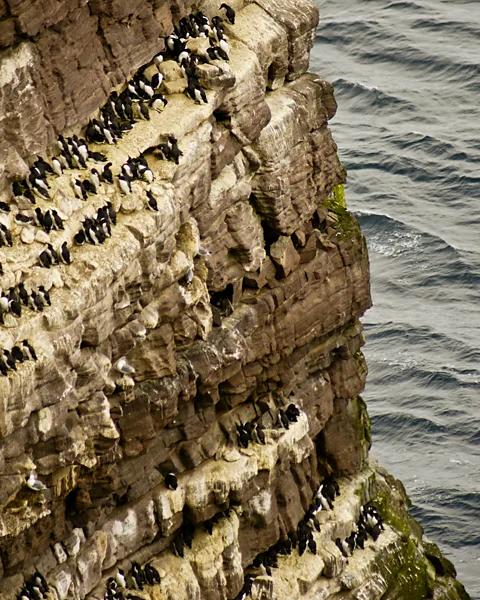 Getty Images
Getty ImagesFor all its abundance of natural charms, life on the island isn't without its challenges. "We rely on the ferry service to get off the island for supplies, and once we had no boats for eight days due to poor weather," Smith told me. "But the peace and solitude of the island once the visitors have gone is second to none, and you very quickly adapt to island life."
I had a small taste of this isolation when I returned to Handa's dock to find that the ferry service had been temporarily suspended due to the spring tide making passage too difficult. It would have been easy to bemoan the loss of that time and the things I could have been doing, but instead I gave myself up to island life, watching eider ducks swim in the shallows and digging my bare feet into the soft sand. When the ferry finally arrived, I found myself reluctant to leave.
Green Getaways is a BBC Travel series that helps travellers experience a greener, cleaner approach to getting out and seeing the world.
--
If you liked this story, sign up for The Essential List newsletter – a handpicked selection of features, videos and can't-miss news, delivered to your inbox twice a week.
